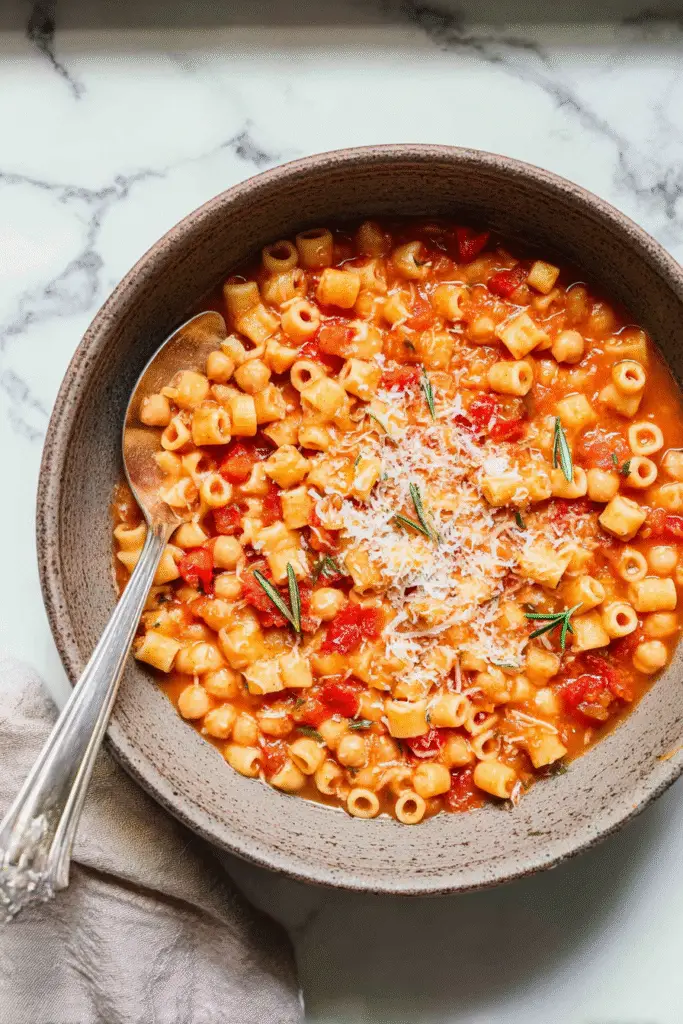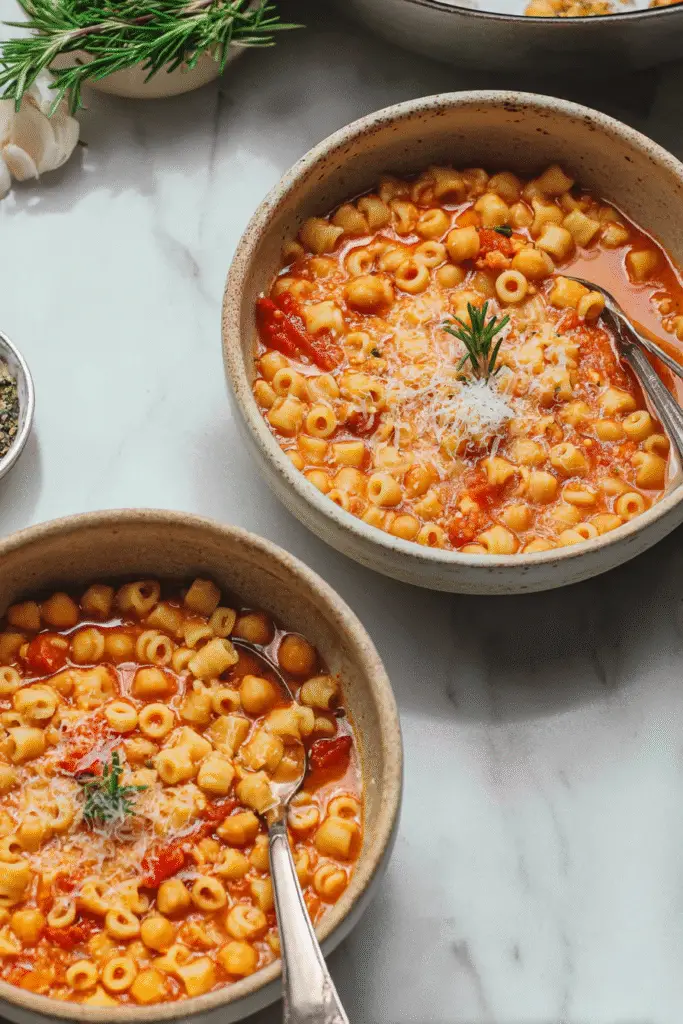When it comes to Italian comfort food, few dishes rival the rustic simplicity of Pasta e Ceci. Translating to “pasta and chickpeas,” this hearty one-pot meal is as traditional as it gets.
Born in the humble kitchens of central and southern Italy, Pasta e Ceci is proof that you don’t need expensive ingredients or complicated techniques to create a dish that’s nourishing, flavorful, and deeply satisfying.
In this long-form article, we’ll explore the origins of Pasta e Ceci, why it remains such a beloved dish in Italy, and how you can prepare it authentically at home.

We’ll share a detailed recipe, tips, variations, and serving suggestions so that you can recreate this soul-warming classic in your own kitchen.
The Story Behind Pasta e Ceci
Pasta e Ceci is a dish rooted in la cucina povera (the cuisine of the poor), a style of cooking that emphasizes using what’s available to create filling, delicious meals. Chickpeas, being inexpensive, protein-rich, and shelf-stable, were a staple ingredient in many Italian households. Combined with pasta — another pantry essential — they formed the backbone of a meal that sustained families for centuries.
Today, Pasta e Ceci is celebrated not just for its history, but also for its nutritional value and comforting taste. It’s rich in protein and fiber thanks to the chickpeas, while the pasta and broth create a velvety, savory base. Whether you’re Italian or not, this dish embodies the essence of home-cooked comfort.
Ingredients for Authentic Pasta e Ceci
What makes Pasta e Ceci so special is how simple and accessible the ingredients are. Here’s a classic list you can follow:
Core Ingredients
- 2 cups dried chickpeas (or 2 cans, drained and rinsed)
- 2 tablespoons extra-virgin olive oil
- 1 medium onion (finely chopped)
- 2 cloves garlic (minced)
- 1 carrot (diced)
- 1 celery stalk (diced)
- 1 sprig fresh rosemary (or 1 teaspoon dried)
- 1 bay leaf
- 1 cup tomato passata (or canned crushed tomatoes)
- 6 cups vegetable or chicken broth
- 1½ cups short pasta (ditalini, tubetti, or small shells)
- Salt and freshly ground black pepper (to taste)
Optional Garnishes
- Extra-virgin olive oil (for drizzling)
- Fresh parsley (chopped)
- Grated Pecorino Romano or Parmesan cheese
- Crushed red pepper flakes
Step-by-Step Instructions (Unique & Authentic)
Step 1: Prepare the Chickpeas
- If using dried chickpeas, soak them overnight in plenty of water with a teaspoon of baking soda. Rinse thoroughly before cooking.
- Simmer soaked chickpeas in fresh water for 1–2 hours until tender, then drain. If using canned chickpeas, simply rinse and set aside.
Step 2: Build the Flavor Base
- Heat olive oil in a large pot over medium heat.
- Add onion, carrot, and celery. Sauté until softened and fragrant, about 8 minutes.
- Stir in garlic, rosemary, and bay leaf. Cook for another minute.
Step 3: Add Tomatoes and Chickpeas
- Pour in the tomato passata and cook for 5 minutes, allowing the sauce to reduce slightly.
- Add chickpeas and stir well to coat with the tomato mixture.
Step 4: Simmer the Broth
- Pour in the broth and bring to a gentle boil.
- Lower the heat and let the mixture simmer for 20 minutes, allowing flavors to meld.
Step 5: Cook the Pasta
- Add the pasta directly into the pot.
- Stir frequently as the pasta cooks, ensuring it doesn’t stick to the bottom.
- Cook until pasta is al dente. The starch released from the pasta will naturally thicken the soup.
Step 6: Adjust and Serve
- Remove the bay leaf and rosemary sprig.
- Taste and adjust seasoning with salt and pepper.
- Ladle into bowls and garnish with olive oil, parsley, cheese, and red pepper flakes if desired.
Tips for Making the Best Pasta e Cec
- Choose the right pasta – Small shapes like ditalini or tubetti are traditional and give the dish its rustic charm.
- Don’t rush the chickpeas – If you’re using dried beans, cook them slowly until tender; this builds flavor and texture.
- Texture matters – For creaminess, mash a portion of the chickpeas before adding the pasta.
- Quality olive oil – A drizzle of extra-virgin olive oil before serving elevates the flavor.
- Make it ahead – Pasta e Ceci tastes even better the next day as the flavors continue to develop.
Variations of Pasta e Ceci
- Roman Style: Uses anchovies and sometimes a touch of tomato paste for a stronger umami flavor.
- Tuscan Style: Often includes fresh herbs like sage and is slightly thicker, more like a stew.
- Calabrian Style: Adds a spicy kick with red pepper flakes or Calabrian chili paste.
- No-Tomato Version: Focuses on garlic, rosemary, and olive oil for a lighter, golden broth.
- Gluten-Free Version: Substitute pasta with gluten-free varieties like rice pasta or chickpea pasta.
What to Serve with Pasta e Ceci
While Pasta e Ceci can easily stand alone as a meal, here are a few side dishes that pair beautifully:
- Crusty Italian bread or focaccia
- A simple arugula salad with lemon dressing
- Roasted seasonal vegetables
- A glass of red wine like Chianti or Montepulciano
Storage and Reheating
- Refrigeration: Store leftovers in an airtight container for up to 3 days.
- Freezing: Best without pasta (freeze chickpeas and broth base, then add pasta fresh when reheating).
- Reheating: Warm gently on the stove, adding extra broth if too thick.
Frequently Asked Questions
1. Can I use canned chickpeas for Pasta e Ceci?
Yes! While dried chickpeas give a more authentic texture and flavor, canned chickpeas are convenient and work just fine.
2. How thick should Pasta e Ceci be?
It’s traditionally somewhere between a soup and a stew. Adjust with more broth if you like it soupy, or let it cook down for a thicker consistency.
3. Can I make Pasta e Ceci vegan?
Absolutely. Use vegetable broth and skip the cheese garnish.
4. What’s the difference between Pasta e Ceci and Pasta e Fagioli?
Pasta e Ceci uses chickpeas, while Pasta e Fagioli uses beans like cannellini or borlotti. Both are traditional Italian comfort foods.
5. Can I prepare it in a slow cooker?
Yes. Cook chickpeas, broth, and aromatics on low for 6–8 hours. Add pasta 30 minutes before serving.
Final Thoughts
Pasta e Ceci is the epitome of rustic Italian comfort food. With just a handful of humble ingredients — pasta, chickpeas, and a fragrant base of aromatics — you can create a dish that is both hearty and deeply satisfying. Its beauty lies in its simplicity, yet its flavor is rich enough to stand alongside more elaborate dishes.

